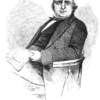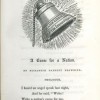
Joseph Viscomi, “William Blake’s 1818 Letter to Dawson Turner and Later Career as Graphic Artist”
Blake printed approximately 157 copies of sixteen illuminated books between 1789 and June 1818. All but fourteen were printed by the end of 1795, by which time Blake had copies of all saleable books in stock and began taking on new “designing and painting” projects. In the twenty-three years between 1795 and 1818, Blake printed illuminated books only four times, for fourteen copies of four titles. In 1818, Blake received an enquiry from Dawson Turner for a “selection” of illuminated designs printed in colors like those Blake had produced for Ozias Humphry in 1796 and which are now known as the Large Book of Designs and Small Book of Designs. Blake refused and redirected Turner to illuminated books and large monoprints, none of which he purchased. Nevertheless, Blake’s letter to Turner marks the moment when Blake was willing to return to a body of work that, with very few exceptions, he had not touched in more than two decades and which he had explicitly declined to reprint in 1808. That decision in 1818, along with a commission from another collector shortly after he wrote Turner, made possible his resurgence in his last decade, as poet, publisher, illustrator, painter, and, equally significant, as original graphic artist. This essay examines Blake’s letter in detail to reveal why he refused Turner’s request, had stopped printing most of his illuminated books, and stopped color printing and monoprinting altogether. It reads the letter closely in light of Blake’s labor history to reveal the idea he had of himself as an artist, the attitude he had toward the hierarchy in the arts, and the works he believed made his “great reputation as an Artist.”

Rebecca Nesvet, “Miss Whitehead, ‘The Bank Nun’”
An urban legend maintains that early in the nineteenth century, one Miss Whitehead, colloquially known as “the Bank Nun,” frequently visited the Bank of England to accuse that institution of destroying her brother, a financial forger. This essay traces the evolution of this legend. I contend that in 1837, an obscure comic sketch reacted to that year’s major financial crisis by dredging up the Romantic-era case of financial forger Paul Whitehead and focusing on his surviving sister. Displacing her brother’s notoriety onto her, the sketch reinvents her as “the Bank Nun,” a grotesque magnet for lingering Romantic-era anxieties about the circulation of paper credit, financial forgery, and women. A succession of plagiarisms, retellings, and reappraisals of this ephemeral sketch and its portrait illustration made the Bank Nun a folk heroine of enduring resonance. Via this iconic figure, Romantic-era economic controversy haunts London today.

Troy J. Bassett, “‘More than a Bookseller’: Iredale’s Library as the Center of Provincial Literary Life”
Andrew Iredale welcomed Her Royal Highness Princess Victoria and her cousins to his library in Toquay, Devon on 1 September 1898 where the group bought books and photographs. Founded by Iredale in 1872, Iredale’s Library became the “centre of literary life” in the seaside resort community well into the twentieth century. This article considers the circulating library’s role in the community: in addition to selling and lending books, the library served as a place for public and private meetings, third-party business transactions, and interpersonal networking. As the history of Iredale’s Library illustrates, provincial circulating libraries played a vital role in communities well beyond their money-making operations.

James Najarian, “Alexander Burnes’s Travels into Bokhara (1834)”
Alexander Burnes’s Travels into Bokhara (1834) is a foundational text of the British fascination with Central Asia, both in a geopolitical sense—the “Great Game” of the rivalry between Britain and Russia in Asia—and in a literary one. It is the most prominent of many travelogues of Afghanistan and Central Asia that relate experiences from the late 1820s to late 1830s, preceding the First Anglo-Afghan War (1839-42). Burnes’s Travels sold well and were immediately translated into French. For a time “Bokhara Burnes” was a literary celebrity. Yet the sensation of his Travels led him to another, less successful appointment in Kabul and finally to his third and final appointment there, as British envoy during the war. Not only was Burnes Britain’s leading Afghan expert; he also became the Afghans’ leading target. His murder sparked the course of the British rout. With a turn to his Persian secretary Mohan Lal Kashmiri’s account of the same travels in his Travels in the Panjab, this paper examines Burnes, his career, and his Travels in order to understand the events and his text’s role in them.

Joanne Wilkes, “The Implications of the Cricket Match in Anthony Trollope’s The Fixed Period (1882)”
Anthony Trollope’s late novel The Fixed Period (1882), set a century in the future in a fictional South Pacific island, has often puzzled readers. It deals with a policy of compulsory euthanasia in the politically independent island of Britannula, a policy that is overturned when the island is taken over by Britain. My article aims to explain an odd interlude in the novel: a cricket match in Britannula between a local and an English team. Drawing on the history of cricket matches between England and its antipodean colonies around the time of the novel’s composition, I argue that the cricketing interlude serves to highlight the text’s take on the Britannulans. This community, living a hundred years in the future, claims to be autonomous, but it possesses a mindset still governed by a sense of Britain as the “mother country.” Hence Trollope emphasizes how difficult it is for settler societies to shake off such attitudes and ties.

Matthew Jones, “On Nineteenth-Century Welsh Literacies, and the ‘Blue Book’ Education Reports of 1847”
This essay considers the 1847 Reports of the Commissioners of Inquiry into the State of Education in Wales, better known as the “Blue Books,” which alleged that Wales’s Welsh-speaking population was benighted, immoral, superstitious, and barbarous, and in need of English-language education. These factors were said to be compromising the country’s modernization while also, in more quiet ways, threatening British society more broadly. The Welsh language was the primary target, and it was deemed antiquated and unfit for commercial and imperial life. Through the Welsh language, the Blue Books also inveighed against Welsh motherhood, Wales’s increasing Nonconformity, and its recharged and growing literary culture. I place the Blue Books in a larger nineteenth-century Welsh context, focusing especially on how rising rates of literacy and religiosity across the country countered the Blue Books’ primary claims. I discuss with particular emphases the Welsh Calvinistic Methodist movement, the antiquarian movement, the revived eisteddfod literary festival, and the influences of Welsh women in Welsh society and as Welsh mothers. Furthermore, I argue that the Blue Books borrowed much colonialist rhetoric then in fashion that disparaged Irish, Indian, Chinese, and African people. With this in mind, the Blue Books fit in among contemporary colonial documents, and they construct the Welsh in similar manners to how other non-English populations were during this moment of Victorian Britain.

Janice Schroeder, “The Publishing History of Henry Mayhew’s London Labour and the London Poor”
Versions of Henry Mayhew’s massive social survey London Labour and the London Poor appeared in several publishing formats, including newspaper column, weekly serial, live stage show, and bound volume. This article traces the republication and remediation of London Labour alongside Mayhew’s repackaging of his interviews with London “street-folk” from 1849 onwards. I offer a succinct, accessible account of the complex publishing history of the text, from print newspaper column to digital edition.

Jonathan Mulrooney, “Edmund Kean, Event”
This article considers Regency actor Edmund Kean’s presence as a figure in the theatrical news of the day, arguing that Kean’s acting style, coupled with changes in periodical print culture, reframed the relation between the British theatrical tradition, the actor’s stage performance, and audience reception. Emphasizing an “illegitimate” grammar of representation characterized by gesture, mobility, and emotional transition, Kean enacted new forms of subjectivity that aligned with emerging modes of theatrical criticism to shape readers’ concepts of their own private experience and their imagined engagement with public events.

Kathleen Frederickson, “British Writers on Population, Infrastructure, and the Great Indian Famine of 1876-8”
This article examines British writing about the 1876-8 famine in southern and western India. In British newspapers and journals, the turn to thinking about famine in terms of the total population obscured the extreme variations in food access that worsened with rising economic inequality. When the British press in the late-1870s turned to human causes of famine, they either argued that India’s population overburdened India’s land, or suggested that more rail construction would prevent enough deaths sufficiently to mitigate British responsibility for famine conditions. The turn to population-based arguments helped either to perpetuate the belief that famine was a quasi-natural part of India or to parse the sudden increase in the frequency and severity famines in India under British rule.

Denae Dyck and Marjorie Stone, “The ‘Sensation’ of Elizabeth Barrett Browning’s Poems before Congress (1860): Events, Politics, Reception”
Elizabeth Barrett Browning’s Poems before Congress paradoxically addresses a political event that never took place: a meeting of European powers to discuss the “Italian question” planned for January of 1860. Nevertheless, the collection addresses several momentous historical developments, including the Second Italian War of Independence in 1859, the intervention of Napoleon III of France in the Italian struggle, and the international conflict his intervention precipitated. Indeed, the book’s publication and the sensation it created in themselves constitute a plurality of events, since the collection appeared under differing titles in England and America and encountered differing responses in each country. Contrary to the still dominant critical view that the volume was almost universally denounced, its reception was shaped by diverse locations, shifting chronological contexts, and conflicting political affiliations. Close analysis of the reviews underscores the importance of these wider contexts, which influence what otherwise appear to be primarily literary or aesthetic judgements. At the same time, analysis of varying responses to not only “A Curse for a Nation” but also “Napoleon III in Italy” and other poems in the volume demonstrates a number of recurring points of contention. These include the collection’s title, the politics of interventions across national borders, English liberalism, the nature of democracy, cosmopolitanism versus nationalism, women writers in relation to politics, poetic form, and, most of all, EBB’s representation of Napoleon III—the issue that is front and centre in most of the 1860s reviews and that shaped, in turn, reactions to all the rest.
